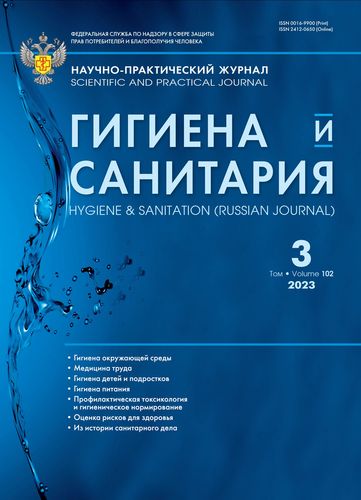Thermal state of the body of workers exposed to extreme levels of infrared radiation and prevention overheating
- Authors: Kharitonov V.I.1
-
Affiliations:
- Ryazan State Medical University named after academician I.P. Pavlov
- Issue: Vol 102, No 3 (2023)
- Pages: 241-246
- Section: OCCUPATIONAL HEALTH
- Published: 24.04.2023
- URL: https://kld-journal.fedlab.ru/0016-9900/article/view/638595
- DOI: https://doi.org/10.47470/0016-9900-2023-102-3-241-246
- ID: 638595
Cite item
Full Text
Abstract
Introduction. In an industrial environment, the thermal effect of a heating microclimate on a person through extreme levels of infrared radiation is a stressful factor that has a pronounced negative effect on the formation of the thermal state of the body, which requires the development of effective measures to prevent overheating.
The purpose of the study is to investigate the peculiarities of the formation of the thermal state of the body in the conditions of a production experiment under exposure to extreme levels of infrared radiation against the background of long-term heavy factory work and the justification of a set of effective measures to prevent overheating.
Materials and methods. The study of the thermal state of the body is conducted in the conditions of real blacksmithing production in accordance with the methodological instructions of MUK 4.3.1895–04 and the provisions of the standard GOST R ISO 9886–2008.
Results. In modern forging and pressing production, one of the most unfavourable factors of the production environment is the intense thermal radiation from the metal heated to technological temperatures, which affects the total for 5–6 hours per shift against the background of high temperature from the heating furnaces themselves, which leads to the development of chronic overheating in workers. The main sources of thermal radiation include incandescent to a temperature of over 1200°С with metal forgings of various lengths and various profile configurations, which largely determines the variability in the degree of radiation intensity of the radiant energy flow at the workplaces of blacksmiths and heaters. The formed thermal state of the workers of the studied occupational groups, dressed in standard cotton workwear, during the performance of the main work operations during the first half of the working shift in the cold and warm periods of the year, is estimated as the maximum permissible, requiring a limit of working time – no more than one hour per working shift. It is necessary to develop requirements for the working regime for prolonged heavy physical work in conditions of extreme exposure to a heating microclimate and the mandatory use of modern effective personal protective equipment (PPE) from infrared radiation.
Limitations. The limitation of the study is the possibility of using the results obtained directly to a specific production, characterized by multifactorial effects against the background of extreme levels of the heating microclimate, rigidly determined by the technological process. The obtained indicators of the thermal condition of workers dressed in standard cotton workwear are estimated as the maximum permissible for a period of no more than one hour per work shift, which justifies the need to search for new effective personal protective equipment for the body of workers.
Conclusion. It is necessary to develop requirements for the working regime during prolonged hard physical work in conditions of extreme exposure to a heating microclimate and the mandatory use of modern effective PPE from infrared radiation of extreme levels.
Compliance with ethical standards. The study was conducted in accordance with ethical and legal standards set out in the Helsinki Declaration of the World Medical Association (World Medical Association Declaration of Helsinki).
Patient consent. Each participant of the study (or his/her legal representative) gave informed voluntary written consent to participate in the study and publish personal medical information in an impersonal form in the journal "Gigiena i Sanitariya (Hygiene and Sanitation, Russian journal)".
Conflict of interest. The authors declare no conflict of interest.
Acknowledgement. The study had no sponsorship.
Received: December 9, 2022 / Accepted: March 24, 2023 / Published: April 20, 2023
About the authors
Valery I. Kharitonov
Ryazan State Medical University named after academician I.P. Pavlov
Author for correspondence.
Email: v.i.haritonov@bk.ru
ORCID iD: 0000-0002-7098-6130
MD, PhD, DSci., Professor of the Department of Specialized Hygienic Disciplines with the course of Hygiene, Epidemiology and organization of the State Sanitary and Epidemiological Service of the Federal Medical Service, Ryazan State Medical University named after academician I.P. Pavlov, Ryazan, 390026, Russian Federation.
e-mail: v.i.haritonov@bk.ru
Russian FederationReferences
- Tilis A.Yu. Overheating. In: Pathological physiology of extreme conditions [Patologicheskaya fiziologiya ekstremal’nykh sostoyaniy]. Moscow: Meditsina; 1973: 180–221. (in Russian)
- Afanas’eva R.F., Suvorov V.G. Integral assessment of the complex of factors that cause thermal stress on workers. Meditsina truda i promyshlennaya ekologiya. 2002; (8): 9–15. (in Russian)
- Losik T.K., Afanas’eva R.F., Konstantinov E.I. Physiologic and hygienic evaluation of heat state in military men performing continuous physical work in heating microclimate. Meditsina truda i promyshlennaya ekologiya. 2015; (10): 41–5. (in Russian)
- Kharitonov V.I. Assessment of occupational health risk with multifactorial intensive exposure. Rossiyskiy mediko-biologicheskiy vestnik imeni akademika I.P. Pavlova. 2017; 25(4): 575–85. https://doi.org/10.23888/PAVLOVJ20174575-585 (in Russian)
- Kharitonov V.I. On the concept of extremity. Rossiyskiy mediko-biologicheskiy vestnik imeni akademika I.P. Pavlova. 2014; (4): 155–60. (in Russian)
Supplementary files









